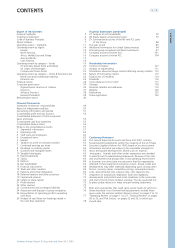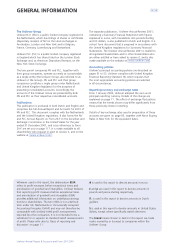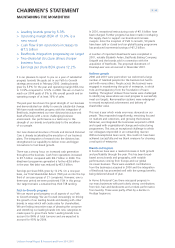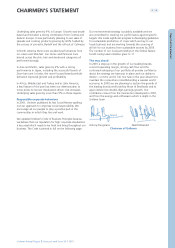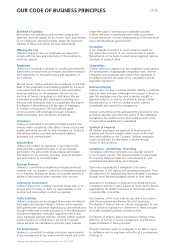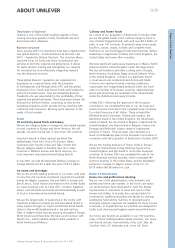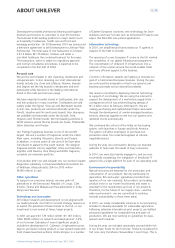Unilever 2001 Annual Report Download - page 14
Download and view the complete annual report
Please find page 14 of the 2001 Unilever annual report below. You can navigate through the pages in the report by either clicking on the pages listed below, or by using the keyword search tool below to find specific information within the annual report.
Unilever Annual Report & Accounts and Form 20-F 2001
>11
Report of the Directors
OPERATING REVIEW – HIGHLIGHTS
Basis of reporting and discussion
The commentary throughout this operating review is,
unless otherwise indicated, based on the results of the
Group including acquisitions made each year, at constant
rates of exchange and before exceptional items and
amortisation of goodwill and intangibles (BEIA). It is also
based on Total turnover and Total operating profit. The term
‘Total’ means Group turnover (and operating profit) plus
Unilever’s share of the turnover (and operating profit) of
joint ventures, net of Unilever’s share of any sales to those
joint ventures already included in the Group figures.
Our accounting policies are based on United Kingdom
generally accepted accounting principles (GAAP) and
Netherlands GAAP which differ in certain respects from
United States GAAP. The principal differences are
described on page 95. We have shown reconciliations to
net income and capital and reserves under US GAAP on
pages 94 and 95.
Reporting currency and exchange rates
From 1 January 2000, Unilever adopted the euro as its
principal reporting currency. For the years prior to the
introduction of the euro on 1 January 1999, euro values
have been derived by converting values previously reported
in guilders using the official conversion rate announced
on 31 December 1998 of 1.00 = Fl. 2.20371. The effect
of exchange fluctuations over time means that the
trends shown may differ significantly from those previously
shown in sterling and from those which would arise if
these euro amounts had been translated from the historic
sterling accounts.
Foreign currency amounts for results and cash flows are
translated from underlying local currencies into euros
using annual average exchange rates; balance sheet
amounts are translated at year-end rates except for the
ordinary capital of the two parent companies. These are
translated at the rate prescribed by the Equalisation
Agreement of £1 = Fl. 12, and thence to euros at the
official rate of 1.00 = Fl. 2.20371 (see Control of
Unilever page 107).
To eliminate the effect of exchange rate fluctuations in the
following discussion, we have expressed certain of our key
year-on-year comparisons at constant rates of exchange.
This means using the annual average rates for the prior year.
For each two-year period, the year-on-year comparisons in
euros are the same as those which would arise if the
results were shown in sterling or US dollars at constant
exchange rates.
For the reporting of 2000 at current exchange rates, the
results of the Bestfoods business acquired on 4 October of
that year were translated at the average rates of exchange
for the last quarter of 2000. In the constant rate comparisons
for 2001 included in the Operating Review on pages 14 to
27, the results for all parts of the Group have been
translated at average rates of exchange for the full year to
31 December 2000. This means that the 2000 results in
these comparative tables will differ in some cases from the
values translated at current rates of exchange.
Details of exchange rates used in preparation of these
accounts and of the noon buying rates against the US dollar
are given on page 93.
2001 results compared with 2000
Total turnover increased by 11% to 53 400 million.
This increase was the result of an acquisition impact of 12%,
a disposal impact of (5)% and underlying growth of 4%.
Total operating profit BEIA increased by 28% to
7 416 million, and total operating margin BEIA rose
to an historic high of 13.9% from 12.0% in 2000.
The improvement in margin primarily reflects the
ongoing contribution from Path to Growth restructuring
and procurement savings and the successful integration
of Bestfoods.
Total operating profit increased by 60% to 5 360 million,
being primarily the net impact of acquisitions and disposals
offset by an increase in the amortisation charge.
Exceptional items
Exceptional items for the year were 620 million, which
includes 1 564 million of restructuring investment and
profits on disposals of 944 million. Of the latter,
828 million relates to the profit on the sale of the
brands to secure regulatory approval for our acquisition
of Bestfoods and 116 million in respect of the sale of
Unipath. Associated costs included in operating profit
were 393 million for the year.
The exceptional items incurred in the year primarily relate
to the Path to Growth programme we announced on
22 February 2000 to accelerate growth and expand
margins, and to restructuring arising from the integration
of Bestfoods. The aggregate cost of these programmes is
estimated to be 6.2 billion, the majority of which is
expected to be exceptional. The 828 million profit on
the sale of brands to secure regulatory approval for the
acquisition of Bestfoods is not part of this amount.


